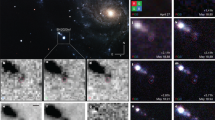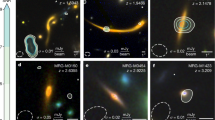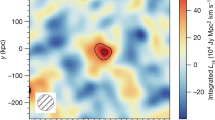Abstract
Ultraluminous infrared galaxies are among the most luminous objects in the local Universe and are thought to be powered by intense star formation1,2. It has been shown that in these objects the rotational spectral lines of molecular hydrogen observed at mid-infrared wavelengths are not affected by dust obscuration3, but left unresolved was the source of excitation for this emission. Here I report an analysis of archival Spitzer Space Telescope data on ultraluminous infrared galaxies and demonstrate that dust obscuration affects star formation indicators but not molecular hydrogen. I thereby establish that the emission of H2 is not co-spatial with the buried starburst activity and originates outside the obscured regions. This is unexpected in light of the standard view that H2 emission is directly associated with star-formation activity3,4,5. I propose the alternative view that H2 emission in these objects traces shocks in the surrounding material that are excited by interactions with nearby galaxies. Large-scale shocks cooling by means of H2 emission may accordingly be more common than previously thought. In the early Universe, a boost in H2 emission by this process may have accelerated the cooling of matter as it collapsed to form the first stars and galaxies, and would make these first structures more readily observable6.
This is a preview of subscription content, access via your institution
Access options
Subscribe to this journal
Receive 51 print issues and online access
$199.00 per year
only $3.90 per issue
Buy this article
- Purchase on Springer Link
- Instant access to full article PDF
Prices may be subject to local taxes which are calculated during checkout



Similar content being viewed by others
References
Sanders, D. B. & Mirabel, I. F. Luminous infrared galaxies. Annu. Rev. Astron. Astrophys. 34, 749–792 (1996)
Genzel, R. et al. What powers ultraluminous IRAS galaxies? Astrophys. J. 498, 579–605 (1998)
Higdon, S. J. U., Armus, L., Higdon, J. L., Soifer, B. T. & Spoon, H. W. W. A Spitzer Space Telescope Infrared Spectrograph survey of warm molecular hydrogen in ultraluminous infrared galaxies. Astrophys. J. 648, 323–339 (2006)
Roussel, H. et al. Warm molecular hydrogen in the Spitzer SINGS galaxy sample. Astrophys. J. 669, 959–981 (2007)
Hollenbach, D. J. & Tielens, A. G. G. M. Dense photodissociation regions (PDRs). Annu. Rev. Astron. Astrophys. 35, 179–215 (1997)
Appleton, P. N. et al. The Dark Side of Reionization: Probing Cooling in the Early Universe. Astro2010: The Astronomy and Astrophysics Decadal Survey, Cosmology and Fundamental Physics Panel, Science White Paper no. 2 (US National Academies of Science, 2009); preprint at http://arxiv.org/abs/0903.1839.
Imanishi, M. et al. A Spitzer IRS low-resolution spectroscopic search for buried AGNs in nearby ultraluminous infrared galaxies: a constraint on geometry between energy sources and dust. Astrophys. J. Suppl. Ser. 171, 72–100 (2007)
Houck, J. R. et al. The infrared spectrograph (IRS) on the Spitzer Space Telescope. Astrophys. J. Suppl. Ser 154, 18–24 (2004)
Allamandola, L. J., Tielens, A. G. G. M. & Barker, J. R. Interstellar polycyclic aromatic hydrocarbons: the infrared emission bands, the excitation/emission mechanism, and the astrophysical implications. Astrophys. J. Suppl. Ser. 71, 733–775 (1989)
Hao, L. et al. The distribution of silicate strength of AGNs and ULIRGs. Astrophys. J. 655, L77–L80 (2007)
Spoon, H. W. W. et al. Mid-infrared galaxy classification based on silicate obscuration and PAH equivalent width. Astrophys. J. 654, L49–L52 (2007)
Kennicutt, R. C. et al. SINGS: The SIRTF nearby galaxies survey. Publ. Astron. Soc. Pacific 115, 928–952 (2003)
Shi, Y. et al. Aromatic features in AGNs: star-forming infrared luminosity function of AGN host galaxies. Astrophys. J. 669, 841–861 (2007)
van der Werf, P. P. et al. Near-infrared line imaging of NGC 6240 – collision shock and nuclear starburst. Astrophys. J. 405, 522–537 (1993)
van der Werf, P. P. in Galaxy Interactions at Low and High Redshift (eds Barnes, J. E. & Sanders, D. B.) 303–306 (International Astronomical Union, 1999)
Kim, D.-C., Veilleux, S. & Sanders, D. B. Optical and near-infrared imaging of the IRAS 1 Jy sample of ultraluminous infrared galaxies. I. The atlas. Astrophys. J. Suppl. Ser. 143, 277–314 (2002)
Rieke, G. H. et al. 1012L⊙ starbursts and shocked molecular hydrogen in the colliding galaxies Arp 220 ( = IC 4553) and NGC 6240. Astrophys. J. 290, 116–124 (1985)
Appleton, P. N. et al. Powerful high-velocity dispersion molecular hydrogen associated with an intergalactic shock wave in Stephan’s Quintet. Astrophys. J. 639, L51–L54 (2006)
Egami, E., Rieke, G. H., Fadda, D. & Hines, D. C. A large mass of H2 in the brightest cluster galaxy in Zwicky 3146. Astrophys. J. 652, L21–L24 (2006)
Ogle, P. et al. Shocked molecular hydrogen in the 3C 326 radio galaxy system. Astrophys. J. 668, 699–707 (2007)
Guillard, P., Boulanger, F., Pineau des Forêts, G. & Appleton, P. N. H2 formation and excitation in the Stephan’s Quintet galaxy-wide collision. Astron. Astrophys. 502, 515–528 (2009)
Monreal-Ibero, A., Arribas, S. & Colina, L. LINER-like extended nebulae in ULIRGs: shocks generated by merger-induced flows. Astrophys. J. 637, 138–146 (2006)
Forbes, D. A. et al. High-resolution imaging of forbidden Fe II 1.64 microns, Brackett-gamma, and H2 1–0 S(1) emission in the starburst galaxy NGC 253. Astrophys. J. 406, L11–L14 (1993)
Greif, T. H., Johnson, J. L., Klessen, R. S. & Bromm, V. The first galaxies: assembly, cooling and the onset of turbulence. Mon. Not. R. Astron. Soc. 387, 1021–1036 (2008)
Weingartner, J. C. & Draine, B. T. Dust grain-size distributions and extinction in the Milky Way, Large Magellanic Cloud, and Small Magellanic Cloud. Astrophys. J. 548, 296–309 (2001)
Kemper, F., Vriend, W. J. & Tielens, A. G. G. M. The absence of crystalline silicates in the diffuse interstellar medium. Astrophys. J. 609, 826–837 (2004)
Chiar, J. E. & Tielens, A. G. G. M. Pixie dust: the silicate features in the diffuse interstellar medium. Astrophys. J. 637, 774–785 (2006)
Zakamska, N. L., Gómez, L., Strauss, M. A. & Krolik, J. H. Mid-infrared spectra of optically-selected type 2 quasars. Astron. J. 136, 1607–1622 (2008)
Gerakines, P. A., Schutte, W. A., Greenberg, J. M. & van Dishoeck, E. F. The infrared band strengths of H2O, CO and CO2 in laboratory simulations of astrophysical ice mixtures. Astron. Astrophys. 296, 810–818 (1995)
Smith, J. D. T. et al. The mid-infrared spectrum of star-forming galaxies: global properties of polycyclic aromatic hydrocarbon emission. Astrophys. J. 656, 770–791 (2007)
Acknowledgements
This work was supported by the Spitzer Space Telescope Fellowship provided by NASA through a contract issued by the Jet Propulsion Laboratory, California Institute of Technology, by the John N. Bahcall Fellowship at the Institute for Advanced Study and by the NSF grant AST-0807444. I would like to thank M. Imanishi for providing reduced, flux-calibrated ULIRG data in electronic form and for his permission to use these data for a study of H2 emission. I would like to thank P. Goldreich, J. Krolik and S. Davis for discussions, and H. Spoon and L. Hao for providing electronic data.
Author information
Authors and Affiliations
Corresponding author
Ethics declarations
Competing interests
The author declares no competing financial interests.
Additional information
Readers are welcome to comment on the online version of this article at www.nature.com/nature.
Supplementary information
Supplementary information
This file contains Supplementary Information and Data, Supplementary Figures 1-3, Supplementary Tables 1-2 and References. (PDF 230 kb)
Rights and permissions
About this article
Cite this article
Zakamska, N. H2 emission arises outside photodissociation regions in ultraluminous infrared galaxies. Nature 465, 60–63 (2010). https://doi.org/10.1038/nature09037
Received:
Accepted:
Issue Date:
DOI: https://doi.org/10.1038/nature09037
This article is cited by
-
Observations of luminous infrared galaxies with the Spitzer Space Telescope
Nature Astronomy (2020)
Comments
By submitting a comment you agree to abide by our Terms and Community Guidelines. If you find something abusive or that does not comply with our terms or guidelines please flag it as inappropriate.



